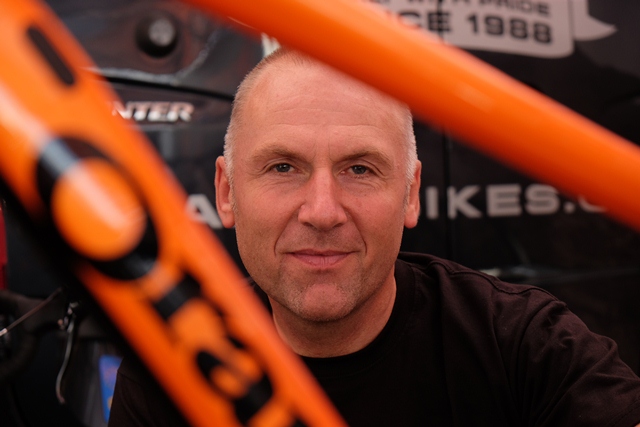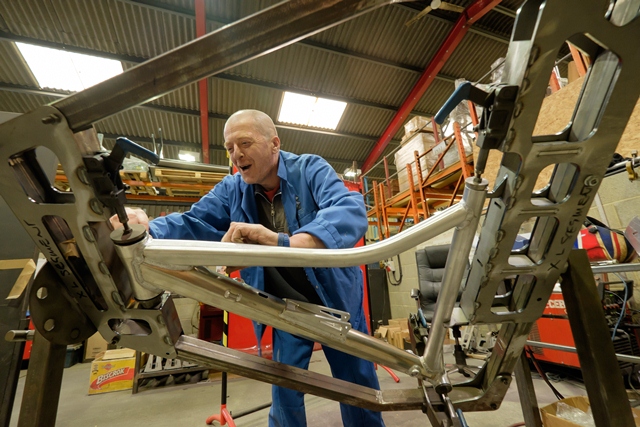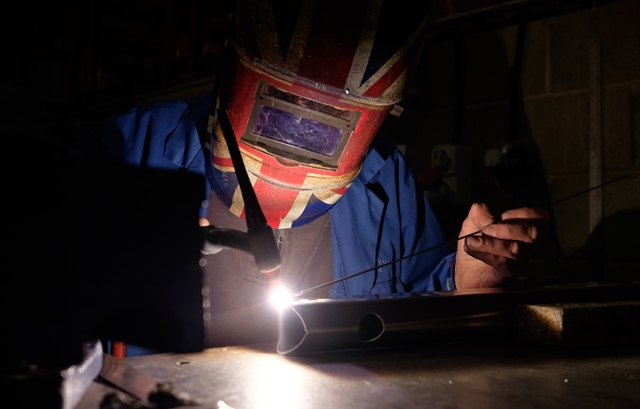Interview: Lester Noble, Orange Bikes
 Orange Bikes has been in business for over 25 years and they are still being made in the UK. Steve Thomas spoke to co-founder Lester Noble to see what makes them tick.
Orange Bikes has been in business for over 25 years and they are still being made in the UK. Steve Thomas spoke to co-founder Lester Noble to see what makes them tick.
Company names are sometimes strangely thought out things. They often carry a deep or personal meaning from the founders, and may be debated and thrashed out over weeks or even months. In some cases the name will be on a scratch pad before the company concept is figured out.
Branding can make or break a company, so how did British bike builder Orange come up with such a simple yet effective name? “We’d already got the company ready and the bikes were in the works. We were really up against time and had less than a day to come up with a name,” Lester Noble recounted. “I like abbreviations, and we’d already been talking about our bikes being the ‘off-road range’ so that was it; the O-range, which came out as Orange.”
Lester is one half of the Orange double-act and back in 1988 he partnered with Steve Wade to launch the brand. Their first bike was the Clockwork, named after the 1971 Stanley Kubrick film and they still have a model by that name in the line-up.
The seeds of Orange had been sewn a few years earlier. “I was part of the Tushingham Sails business and had sailed and windsurfed competitively in the Lake District for years. I took up mountain biking as a way to keep fit during the winter.” Lester was actually an international level sailor.
It was a chance encounter that lured him into mountain biking. “Back in 1984 I was driving through Pateley Bridge in Yorkshire and saw some cars with bikes on top. They had knobbly tyres—I thought that looks like fun, so went out and found one.”
Some of his early rides were taken with long-time friend Steve Wade, and the pair became gripped by the sport. “I was putting a lot of time into training and in 1987 I went to the first World Championships. I finished 29th and best Brit, it was Ned Overend that won.”
By that stage Lester was already designing his own bikes. “We had a couple of early Muddy Foxes. While they were good, around 80% of their customers were in London, so the bikes were becoming more commuter style with 74-degree angles and so on. I didn’t think this worked well off-road—you need a more relaxed bike, even for racing.”
Not long after he decided to put his ideas to the market. “I had some bikes made up locally and started selling them under the Tushingham brand. After a while I decided to leave Tushingham and go it alone.” Thus the Orange partnership came to fruition, “He had just taken over his dad’s sheet metal business in Halifax and that gave us the basic engineering backup.”
GROWING ORANGES
From the outset Orange established themselves as solid players in the UK mountain bike market. “We used to go and ride most of the regional and national races. People saw our bikes and started to ask for them. From the outside it looked like a big team, but in reality it was just a big bunch of mates riding bikes together.”
The early crop of Orange bikes was a huge success. “We started with one frame, and then we introduced another made from Tange Prestige tubing (it was called the Prestige). At that time there were two Shimano groupsets on the market; XT and DR. Then they came out with LX and renamed the DR group to DX. This allowed us to offer six custom options with our two frames.”

MATERIAL GAINS
From the outset, the principal design work had come from Steve Wade. With an engineering background and an insatiable appetite for trails, he was constantly honing and tweaking the range. In 1991 Orange produced their first aluminium frames. “We came up with the Aluminium O, which gave us three more bikes in the range.”
Steve had many years of experience in sheet metalworking and this was applied to create their distinctive ‘monocoque alloy’ designs— something that carries through to the current Orange line up.
NEW FORMULA
During 93/94 they released their first full suspension bike; the Formula. By 96/97 we’d introduced the 628, a six or eight inch travel adjustable suspension design—that bike was basically the father of all the present day Orange bikes.”
Through the late ’90s Orange sponsored the Animal downhill team and also helped a fledgling South African junior who was making his way on the UK scene—Greg Minnaar.
“Around 2000 the Global Racing team formed and they had some big Japanese financial backing. At the last minute their bike sponsor pulled out, so they asked their riders what they wanted to ride. Greg Minnaar said he wanted the Orange 222 and his teammates agreed. Their budget was such that that they even helped us develop the bike further—it was great for us.”

With names like Minnaar, Tracy Moseley, Mick Hannah and Steve Peat on-board, it was great for their profile. “Through their success the riders became worth more than we could offer them,” Lester explained. “When they eventually went elsewhere we decided to focus more on our trail and XC range.”
ORGANICALLY GROWN
Mountain biking has changed hugely in its short lifespan, and Orange has evolved with it. “It’s not been easy of late, with the three different wheel sizes being debated over. It seems that most manufacturers have settled on 650b; although we are still keeping 29ers in the range, as we believe they have merit. It looks like the 26-inch wheel is almost forgotten, or soon will be.”
While Asian manufacture may be cheaper, Orange remains committed to UK based production. “We sell around 5-6,000 bikes a year, and have done around that number for many years. About 20% of them are made in Taiwan, the remaining 80% all come out of our factory in Halifax.”
“Our average frame cost is about double what it would be if we made it in Taiwan, but UK building does have its positives. We are able to tweak things when we want, and to evolve the design much faster than others. We’ve not followed the regular manufacturer’s suit of putting out new models all at the same time; we only release something when it’s ready.”
“Our factory needs to work at the same rate year-round; we’re not in the ‘hire-em and fire em’ business, so we make the same number of bikes in winter as we do in summer.
FUTURE PROOFING
Recently carbon fibre has become the material of choice for many manufacturers. Orange is considering it but remains cautious, “We brought out a carbon road bike a couple of years back, made outside, and we weren’t happy with the lack of control we had over the build process, so we have been working on our own carbon frames. We’re about two years away from being able to produce our own UK built carbon frames, although that’s not to say that we will.”
“We’re just not sure it’s the right material. Unlike aluminium, where you usually see a crack or a ripple before failure with carbon it happens internally. You don’t know until it happens, and it’s usually a catastrophic failure. There is still a strong band of riders that will not ride carbon—especially for long travel and enduro riding. We’ll need to see how our trials pan out.”
Meanwhile both Lester and Steve continue their home grown development process. “I ride three or four times a week while Steve rides almost every day. With Steve it’s always epic all-day rides in serious terrain.” Although the names of the bikes may stay the same, they’re always evolving. “Take the Five for example; in 13 years it’s seen around 20 significant changes.”
With more and more small brands moving their production to Asia, it’s refreshing to see a brand sticking to in-house manufacture—we really hope it works out for them.





